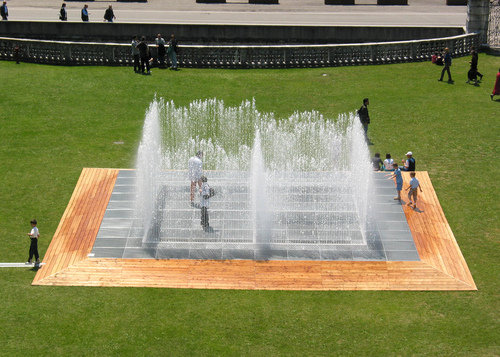Two exhibitions
dal 31/8/2007 al 24/11/2007
Segnalato da
Satashi Ohno
Christian Boltanski
Jim Campbell
Michel Delacroix
Laurent Grasso
Jeppe Hein
William Kentridge
Rafael Lozano-Hemmer
Teresa Margolles
Julie Nord
Regina Silveira
31/8/2007
Two exhibitions
The Contemporary Museum, Honolulu
Phantasmagoria: Specters of Absence + Satashi Ohno: Prism Violet

Phantasmagoria: Specters of Absence + Satashi Ohno: Prism Violet
Phantasmagoria: Specters of Absence
Phantasmagoria: Specters of Absence, brings together 12 international
artists--Christian Boltanski, Jim Campbell, Michel Delacroix, Laurent Grasso, Jeppe
Hein, William Kentridge, Rafael Lozano-Hemmer, Teresa Margolles, Oscar Muñoz,
Julie Nord, Rosângela Rennó, and Regina Silveira--who use ephemeral
means in their work such as fog, reflection, shadows, and vapors. The exhibition
title refers to 18th- and 19th-century entertainments created by "magic
lanterns" and rear-screen shadow projections. These precursors of the modern
film projector were used to stage dancing specters and other frightening theatrical
effects for their audiences. The exhibition draws on this rich theatrical tradition
to reframe questions of absence and loss, death and the afterlife around
contemporary issues.
The shadow--literally, the absence of light--represents something that is beyond the
object yet inseparable from it. In many of the works included in Phantasmagoria,
shadows are used to allude to death, the obscure, and the unnamable, and to
construct allegories of loss and disappearance. In several of these pieces, the
artists evoke performances of shadow theater, as in the work by South African artist
William Kentridge, and in French artist Christian Boltanski's shadows from cut-tin
puppets, recalling imagery from the carnival as well as figurines used to celebrate
the Mexican Day of the Dead.
Mist, breath, and fog are often associated with mystery; in their double status as
perceptible yet almost nonexistent phenomena, they suggest evanescence or absence.
In Brazilian artist Rosângela Rennó’s arresting installation
Experiencing Cinema, fog is employed as a curtain onto which family photos are
projected, addressing the fleeting nature of memories and the images that attempt to
record them. Throughout the installations presented in the exhibition, artists' use
of shadows and/or actual fog and mist evokes the alluring enigma and magic of
Phantasmagoria.
Phantasmagoria: Specters of Absence is accompanied by an illustrated catalogue with
a text by exhibition curator José Roca of the Luis Ángel Arango
Library, Bogotá, Colombia.
Phantasmagoria: Specters of Absence is a traveling exhibition co-organized by iCI
(Independent Curators International), New York, and the Museo de Arte del Banco de
la República, Bogotá, Colombia, and circulated by iCI. The guest
curator for the exhibition is José Roca. The exhibition, tour, and catalogue
are made possible, in part, by the iCI Exhibition Partners and the iCI independents.
The presentation at The Contemporary Museum, Honolulu is made possible in part by
in-kind support for the exhibition in Honolulu has been provided by Horizon Lines,
LLC, Terisol, Inc., and Sony Hawaii.
--------------------------
Satashi Ohno: Prism Violet
The Contemporary Museum presents the first solo museum exhibition of Japanese
artist, Satoshi Ohno (born 1980). Known for his paintings and drawings, Ohno often
presents his works as an installation incorporating found objects and natural
materials.
Elements of nature are prominent in Ohno's work. He grew up in Gifu Prefecture and
moved to Tokyo to study at Tokyo Zokei University. During the seven years he lived
in Tokyo, Ohno made infrequent forays outside the city into natural settings that
made him conscious of the different physical and emotional reactions we experience
in each environment. "I felt as if I were melting into nature and that my
footing on the ground gave me a sensation linked to an inner feeling that I did not
experience in the city… I realized that my footing on concrete was absolutely devoid
of those feelings I had in nature." Images of cedar trees recur in Ohno's
paintings and drawings, further symbolizing the artist's desire to be connected to
nature.
For Ohno the images of the trees became a kind of self-portraiture that
transformed into more literal self-portraits in other works in which his head and
long, cascading hair evoke the shape of the trees. The centerpieces of Ohno’s new
insta
llation are two towering mountain forms made of carpet over wooden structures. The
artist says the mountains make reference to the volcanoes in Hawai'i, his way of
paying tribute to the landscape of the place in which he created this exhibition.
The inspiration for Ohno's TCM installation, Prism Violet, came from a simple
observation: the attraction of insects to light in the darkness of night. It’s an
instinctive, compulsive behavior that in consequence may perish from heat or become
the victims of waiting predators that gather near light sources. Ohno notes that
humans are also drawn to light -- specifically to the light refractive qualities of
prisms and the sparkle of diamonds, which in their man-made faceted forms are like
prisms. Prisms bend and separate light into color spectrums, and Ohno sees viewers'
experience of his installations functioning in a similar way. As people move in and
through his environments they see and experience things from different perspectives.
The experience is dynamic, ever changing, as positions and relationships to objects
change. Ohno wants viewers to sense physical and emotional shifts as they circulate
among and within his works, just as he experienced the effects of time spent
in the urban confines of Tokyo streets or the rustic openness of forest paths.
Satoshi Ohno: Prism Violet was organized by The Contemporary Museum, Honolulu, and
curated by Associate Director/Chief Curator James Jensen. The exhibition is endorsed
by the Consulate General of Japan in Honolulu.
Image: Jeppe Hein
The Contemporary Museum
2411 Makiki Heights Drive - Honolulu



